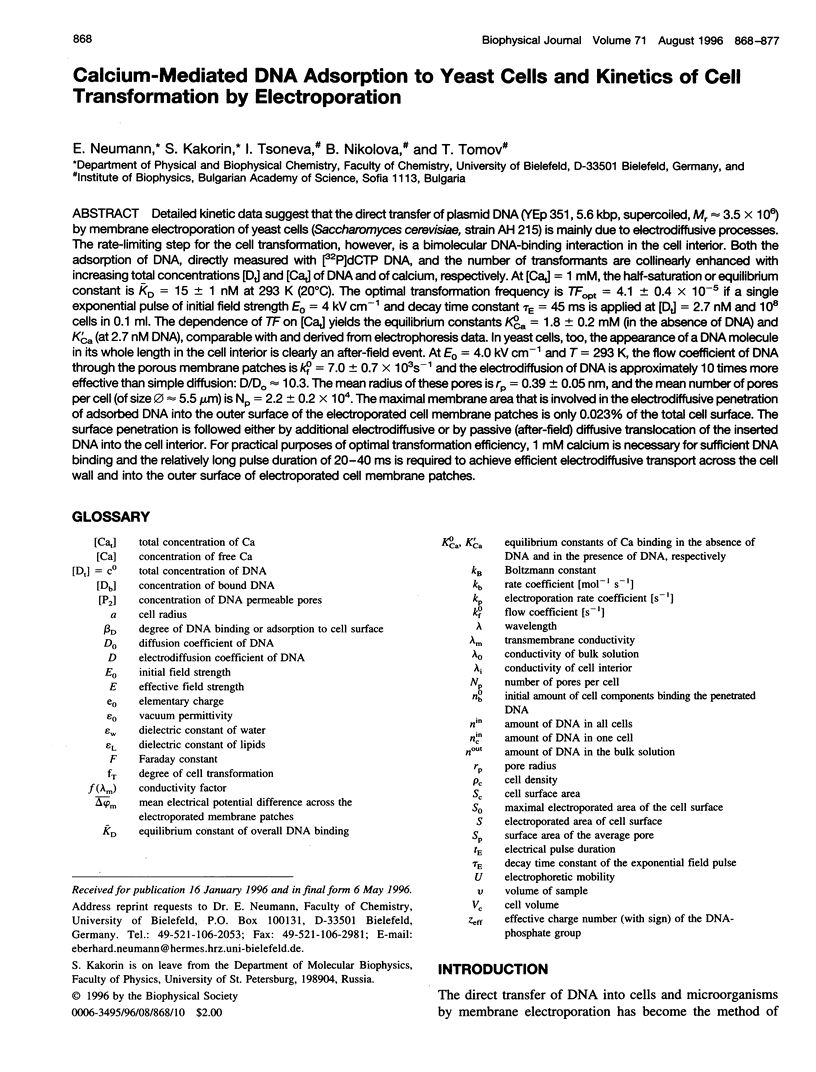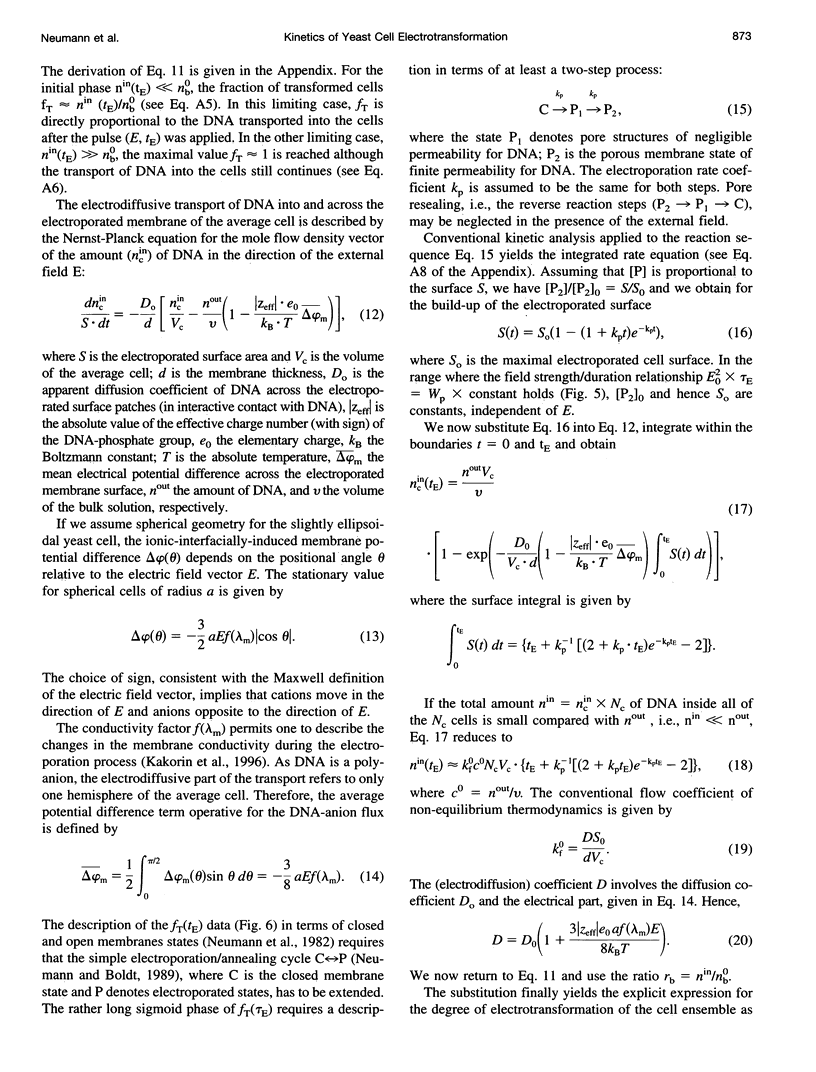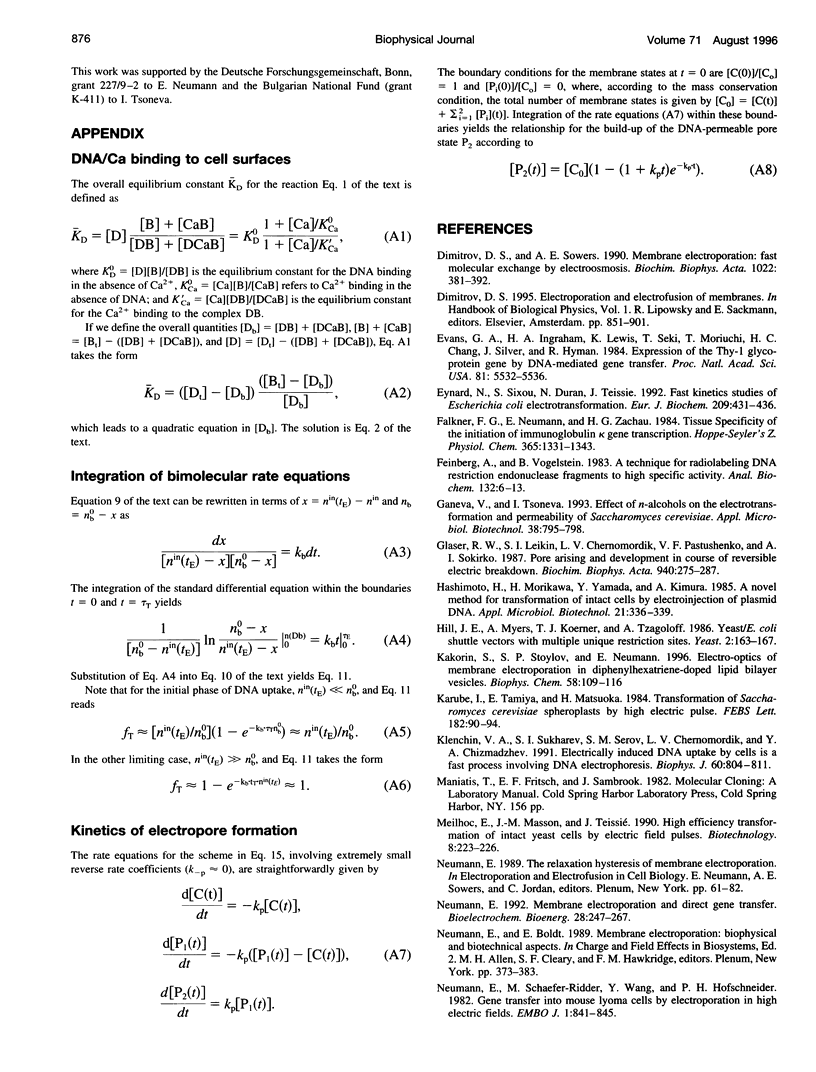Abstract
Detailed kinetic data suggest that the direct transfer of plasmid DNA (YEp 351, 5.6 kbp, supercoiled, Mr approximately 3.5 x 10(6)) by membrane electroporation of yeast cells (Saccharomyces cerevisiae, strain AH 215) is mainly due to electrodiffusive processes. The rate-limiting step for the cell transformation, however, is a bimolecular DNA-binding interaction in the cell interior. Both the adsorption of DNA, directly measured with [32P]dCTP DNA, and the number of transformants are collinearly enhanced with increasing total concentrations [Dt] and [Cat] of DNA and of calcium, respectively. At [Cat] = 1 mM, the half-saturation or equilibrium constant is KD = 15 +/- 1 nM at 293 K (20 degrees C). The optimal transformation frequency is TFopt = 4.1 +/- 0.4 X 10(-5) if a single exponential pulse of initial field strength E0 = 4 kV cm-1 and decay time constant tauE = 45 ms is applied at [Dt] = 2.7 nM and 10(8) cells in 0.1 ml. The dependence of TF on [Cat] yields the equilibrium constants KCazero = 1.8 +/- 0.2 mM (in the absence of DNA) and K'Ca (at 2.7 nM DNA), comparable with and derived from electrophoresis data. In yeast cells, too, the appearance of a DNA molecule in its whole length in the cell interior is clearly an after-field event. At Eo = 4.0 kV cm-1 and T = 293 K, the flow coefficient of DNA through the porous membrane patches is Kto = 7.0 +/- 0.7 x 10(3)S-1 and the electrodiffusion of DNA is approximately 10 times more effective than simple diffusion: D/D0 approximately 10.3. The mean radius of these pores is rp = 0.39 +/- 0.05 nm, and the mean number of pores per cell (of size ø approximately 5.5 microns) is Np = 2.2 +/- 0.2 x 10(4). The maximal membrane area that is involved in the electrodiffusive penetration of adsorbed DNA into the outer surface of the electroporated cell membrane patches is only 0.023% of the total cell surface. The surface penetration is followed either by additional electrodiffusive or by passive (after-field) diffusive translocation of the inserted DNA into the cell interior. For practical purposes of optimal transformation efficiency, 1 mM calcium is necessary for sufficient DNA binding and the relatively long pulse duration of 20-40 ms is required to achieve efficient electrodiffusive transport across the cell wall and into the outer surface of electroporated cell membrane patches.
Full text
PDF









Selected References
These references are in PubMed. This may not be the complete list of references from this article.
- Dimitrov D. S., Sowers A. E. Membrane electroporation--fast molecular exchange by electroosmosis. Biochim Biophys Acta. 1990 Mar;1022(3):381–392. doi: 10.1016/0005-2736(90)90289-z. [DOI] [PubMed] [Google Scholar]
- Evans G. A., Ingraham H. A., Lewis K., Cunningham K., Seki T., Moriuchi T., Chang H. C., Silver J., Hyman R. Expression of the Thy-1 glycoprotein gene by DNA-mediated gene transfer. Proc Natl Acad Sci U S A. 1984 Sep;81(17):5532–5536. doi: 10.1073/pnas.81.17.5532. [DOI] [PMC free article] [PubMed] [Google Scholar]
- Eynard N., Sixou S., Duran N., Teissie J. Fast kinetics studies of Escherichia coli electrotransformation. Eur J Biochem. 1992 Oct 1;209(1):431–436. doi: 10.1111/j.1432-1033.1992.tb17306.x. [DOI] [PubMed] [Google Scholar]
- Falkner F. G., Neumann E., Zachau H. G. Tissue specificity of the initiation of immunoglobulin kappa gene transcription. Hoppe Seylers Z Physiol Chem. 1984 Nov;365(11):1331–1343. doi: 10.1515/bchm2.1984.365.2.1331. [DOI] [PubMed] [Google Scholar]
- Feinberg A. P., Vogelstein B. A technique for radiolabeling DNA restriction endonuclease fragments to high specific activity. Anal Biochem. 1983 Jul 1;132(1):6–13. doi: 10.1016/0003-2697(83)90418-9. [DOI] [PubMed] [Google Scholar]
- Ganeva V. J., Tsoneva I. C. Effect of n-alcohols on the electrotransformation and permeability of Saccharomyces cerevisiae. Appl Microbiol Biotechnol. 1993 Mar;38(6):795–798. doi: 10.1007/BF00167147. [DOI] [PubMed] [Google Scholar]
- Glaser R. W., Leikin S. L., Chernomordik L. V., Pastushenko V. F., Sokirko A. I. Reversible electrical breakdown of lipid bilayers: formation and evolution of pores. Biochim Biophys Acta. 1988 May 24;940(2):275–287. doi: 10.1016/0005-2736(88)90202-7. [DOI] [PubMed] [Google Scholar]
- Hill J. E., Myers A. M., Koerner T. J., Tzagoloff A. Yeast/E. coli shuttle vectors with multiple unique restriction sites. Yeast. 1986 Sep;2(3):163–167. doi: 10.1002/yea.320020304. [DOI] [PubMed] [Google Scholar]
- Kakorin S., Stoylov S. P., Neumann E. Electro-optics of membrane electroporation in diphenylhexatriene-doped lipid bilayer vesicles. Biophys Chem. 1996 Jan 16;58(1-2):109–116. doi: 10.1016/0301-4622(95)00090-9. [DOI] [PubMed] [Google Scholar]
- Klenchin V. A., Sukharev S. I., Serov S. M., Chernomordik L. V., Chizmadzhev YuA Electrically induced DNA uptake by cells is a fast process involving DNA electrophoresis. Biophys J. 1991 Oct;60(4):804–811. doi: 10.1016/S0006-3495(91)82115-4. [DOI] [PMC free article] [PubMed] [Google Scholar]
- Meilhoc E., Masson J. M., Teissié J. High efficiency transformation of intact yeast cells by electric field pulses. Biotechnology (N Y) 1990 Mar;8(3):223–227. doi: 10.1038/nbt0390-223. [DOI] [PubMed] [Google Scholar]
- Neumann E., Schaefer-Ridder M., Wang Y., Hofschneider P. H. Gene transfer into mouse lyoma cells by electroporation in high electric fields. EMBO J. 1982;1(7):841–845. doi: 10.1002/j.1460-2075.1982.tb01257.x. [DOI] [PMC free article] [PubMed] [Google Scholar]
- Potter H., Weir L., Leder P. Enhancer-dependent expression of human kappa immunoglobulin genes introduced into mouse pre-B lymphocytes by electroporation. Proc Natl Acad Sci U S A. 1984 Nov;81(22):7161–7165. doi: 10.1073/pnas.81.22.7161. [DOI] [PMC free article] [PubMed] [Google Scholar]
- Spassova M., Tsoneva I., Petrov A. G., Petkova J. I., Neumann E. Dip patch clamp currents suggest electrodiffusive transport of the polyelectrolyte DNA through lipid bilayers. Biophys Chem. 1994 Nov;52(3):267–274. doi: 10.1016/0301-4622(94)00097-4. [DOI] [PubMed] [Google Scholar]
- Sukharev S. I., Klenchin V. A., Serov S. M., Chernomordik L. V., Chizmadzhev YuA Electroporation and electrophoretic DNA transfer into cells. The effect of DNA interaction with electropores. Biophys J. 1992 Nov;63(5):1320–1327. doi: 10.1016/S0006-3495(92)81709-5. [DOI] [PMC free article] [PubMed] [Google Scholar]
- Wong T. K., Neumann E. Electric field mediated gene transfer. Biochem Biophys Res Commun. 1982 Jul 30;107(2):584–587. doi: 10.1016/0006-291x(82)91531-5. [DOI] [PubMed] [Google Scholar]
- Xie T. D., Sun L., Tsong T. Y. Study of mechanisms of electric field-induced DNA transfection. I. DNA entry by surface binding and diffusion through membrane pores. Biophys J. 1990 Jul;58(1):13–19. doi: 10.1016/S0006-3495(90)82349-3. [DOI] [PMC free article] [PubMed] [Google Scholar]
- Xie T. D., Sun L., Zhao H. G., Fuchs J. A., Tsong T. Y. Study of mechanisms of electric field-induced DNA transfection. IV. Effects of DNA topology on cell uptake and transfection efficiency. Biophys J. 1992 Oct;63(4):1026–1031. doi: 10.1016/S0006-3495(92)81675-2. [DOI] [PMC free article] [PubMed] [Google Scholar]
- Xie T. D., Tsong T. Y. Study of mechanisms of electric field-induced DNA transfection. II. Transfection by low-amplitude, low-frequency alternating electric fields. Biophys J. 1990 Oct;58(4):897–903. doi: 10.1016/S0006-3495(90)82434-6. [DOI] [PMC free article] [PubMed] [Google Scholar]
- Xie T. D., Tsong T. Y. Study of mechanisms of electric field-induced DNA transfection. III. Electric parameters and other conditions for effective transfection. Biophys J. 1992 Jul;63(1):28–34. doi: 10.1016/S0006-3495(92)81580-1. [DOI] [PMC free article] [PubMed] [Google Scholar]
- Xie T. D., Tsong T. Y. Study of mechanisms of electric field-induced DNA transfection. V. Effects of DNA topology on surface binding, cell uptake, expression, and integration into host chromosomes of DNA in the mammalian cell. Biophys J. 1993 Oct;65(4):1684–1689. doi: 10.1016/S0006-3495(93)81208-6. [DOI] [PMC free article] [PubMed] [Google Scholar]


